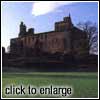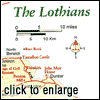|
West Lothian
The west side of Edinburgh is collectively considered
West Lothian. Take the by-pass to its terminal roundabout at Gogar and turn right
back towards Edinburgh, then follow the signs for the Forth Road Bridge. At the Barnton
Roundabout carry straight over for the village of Cramond. Now a middle class suburb
of Edinburgh, Cramond has a long history, being a site for a Roman fort and naval
harbour dated from AD142. From here the Emperor Severus embarked on his northern
campaigns to quell the Picts. The foundations of the fort can still be seen. Recently
a well-preserved Roman lion sculpture was discovered in the river.
 Near the river, there are also remnants of eighteenth century
water mills that ground corn and drove weaving machines, although little is now left
apart from successive weirs. There is a pleasant walk following the river that comes
out at a medieval bridge and finishing off at Cramond Brig Hotel. Near the river, there are also remnants of eighteenth century
water mills that ground corn and drove weaving machines, although little is now left
apart from successive weirs. There is a pleasant walk following the river that comes
out at a medieval bridge and finishing off at Cramond Brig Hotel.
It is possible to take the tiny passenger ferry, a
rowing boat, across the mouth of the Almond River and walk the 2 miles (3km) or so
to Dalmeny House. Alternatively, you can drive following the A90 and turning off
for Dalmeny and South Queensferry. The house is 1 mile (2km) east of the village
of Dalmeny. Built in 1815 it contains a fabulous collection of eighteenth century
French furniture, Napoleonic memorabilia, tapestries, porcelain and British portraits.
The Forth Bridge
 Built in 1890, it is known as one of the engineering wonders
of the world comparable with the Eiffel Tower and the Taj Mahal. A remarkable tribute
to Victorian engineering, it was the first major structure to be made entirely of
steel, with significant extra amounts of the material employed as a result of the
collapse of the Tay Bridge shortly before construction commenced. Its three massive,
double cantilevers expand by almost 3ft (1m) from mid-winter to mid-summer. Built in 1890, it is known as one of the engineering wonders
of the world comparable with the Eiffel Tower and the Taj Mahal. A remarkable tribute
to Victorian engineering, it was the first major structure to be made entirely of
steel, with significant extra amounts of the material employed as a result of the
collapse of the Tay Bridge shortly before construction commenced. Its three massive,
double cantilevers expand by almost 3ft (1m) from mid-winter to mid-summer.
The Forth Road Bridge, commenced in 1962 to replace
the ferries that had crossed between North Queensferry to South Queensferry, was
opened in 1964. The most important function of the Forth Road Bridge, some might
say, is not to take you into Fife but to give a great, elevated platform from which
to view the Forth Bridge. The view from the public footpath is remarkable.
Around South Queensferry
South Queensferry is a charming little village on
the banks of the Forth about 10 miles (16km) west of Edinburgh. At the eastern end
where there are good parking facilities is South Queensferry's most prominent feature,
the Forth Bridge. This rail bridge is unique of its kind and attracts bridge and
rail enthusiasts from around the globe.
Below the russet rivets of the Forth Bridge is the
old ferry landing, still used today, for pleasure craft. David I, to facilitate communication
between his palace at Dunfermline and the south, established the first public ferry
across the Forth at this point in 1129. Pilgrims to Dunfermline and St Andrews were
encouraged to use the free service. Now, the Maid of the Forth sails from Hawes Pier
to Inchcolm Island and its abbey to the north-east throughout the summer. Seals are
often spotted from the boat. Below the rail bridge stands the sixteenth century Hawes
Inn that was the starting place of David Balfour's misadventures in Robert Louis
Stevenson's book, Kidnapped.
Two miles (3kn) west of South Queensferry and 12 miles
(19km) from Edinburgh, Hopetoun House stands at the end of a wide square, its palatial
central structure flanked by gracefully balanced wings. First completed around the
turn of the seventeenth century it was soon enlarged by William Adam and his son,
John, to their oft-repeated and impeccable standard. It remains the home of the Hope
family and Marquess of Linlithgow, and inside displays many fine paintings. The 100
acre (40 hectares) landscaped grounds overlook the Firth of Forth, the best views
of which are found from the viewing platform on the mansion roof. There are attractions
such as a walled garden, a nature trail and deer park.
Following the A904 west from South Queensferry there
are other stately homes and castles to be seen near the south shore of the Forth.
The House of Binns echoes the seventeenth century Scottish transition from the fortified
house to a more self-indulgent mansion style. General Tam Dalyell (pronounced Dee-el),
who sided with the royalists against the Convenanters, was associated with the house.
On display, a heavy table was found in the nearby lake having rested there some 200
years, flung (so it is said) by Tam's acquaintance, the Devil, when he lost to Tam
at cards. Other stories of flagellation parties and glass eating antics give the
visitor, let alone his Covenanting enemies, a rather disquieting impression of the
general.
Nearby Blackness Castle is associated with Linlithgow.
Its massively structured sixteenth century battlements on the north side were built
to withstand the barrage of naval guns, with narrow chambers allowing defenders to
return fire.
Linlithgow
The town of Linlithgow was once nearly as important
as the nearby centres of Stirling and Edinburgh. Beholding today's concoction of
bad 1960s planning and irreverence for former glories, it is hard to comprehend this
was such an important centre. As you drive through the charming town centre and view
the concrete blocks at the end of the main street, you wonder what possessed past
generations of town planners.
Linlithgow Palace
 Linlithgow Palace is best known as the birthplace of Mary
Queen of Scots, born here in 1542 and crowned a week later. Linlithgow Palace's own
history goes back to the time of James I who commissioned the earliest building around
1425. Covering the reign of eight monarchs and two centuries in its progress, James
VI finally completed the palace to its illustrious proportions in 1642. Linlithgow Palace is best known as the birthplace of Mary
Queen of Scots, born here in 1542 and crowned a week later. Linlithgow Palace's own
history goes back to the time of James I who commissioned the earliest building around
1425. Covering the reign of eight monarchs and two centuries in its progress, James
VI finally completed the palace to its illustrious proportions in 1642.
Within its five storeys and rather square hulk supported
by two unusual flying buttresses on the east side, it is not difficult to imagine
what royal panoply furnished the magnificent interior spaces, bed chambers and corridors
that remain now in skeleton form. The palace was burned by accident in 1746 by the
Duke of Cumberland's troops who were garrisoned there for the night. It is possible
to fish on Linlithgow Loch and there are extensive paths around the grounds.
The Great Hall is the building's centre point with
its elaborately fashioned fire recess, while the inner courtyard is embellished with
an octagonal Renaissance fountain. Every Sunday afternoon in August you will find
the Linlithgow Festival Trust players re-enacting Mary Stewart's return to her birthplace
with great pageantry and costume.
Next to the palace gate is St Michael's Parish Church,
one of Scotland's largest pre-reformation churches dedicated in 1242. The church
was re-built in the sixteenth century but the addition of the unusual aluminium 'Crown
of Thorns' spire, standing out like huge crossed claymores, did not take place until
1946. John Knox and his adherents spoiled the church during the Reformation and Oliver
Cromwell used it as a stable.
If you are interested in exploring other aspects of
this area there is Beecraigs Country Park south of Linlithgow that offers trails
through a variety of woodland as well as a deer farm, adventure playground and fishing
loch. There are organised activities such as archery, water sports, angling and orienteering
that can be joined by applying in advance. There is also a caravan park with thirty-six
pitches. A rewarding walk an be found up nearby Cockleroy Hill through pine woods
with unexpectedly fine views as far as Goat Fell on the Arran in the west and Ben
Lomond to the north. Cairnpapple Hill approached from the Beecraigs Roads beyond
the park is well signposted. This rather eerie, ancient Neolithic then early Bronze
Age burial Kist and ceremonial mound still shows the remnants of a standing stone
ring as well as the cairned tomb, which can be entered by ladder.
 In Linlithgow there are often folk evenings held at the Black
Bitch Tavern. The Star and Garter opposite the roundabout at the beginning of the
High Street offers good bar meals. In Linlithgow there are often folk evenings held at the Black
Bitch Tavern. The Star and Garter opposite the roundabout at the beginning of the
High Street offers good bar meals.
The Union Canal in the Linlithgow basin was a short-lived
success as it took nearly 14 hours to traverse the distance between Glasgow and Edinburgh,
while the train when it was introduced in 1842 took only two hours and at the same
price. Short trips on the Victoria, a diesel powered replica of a steam packet boat,
or the Janet Telford passenger boat, are available from Manse Road Basin, and visitors
can gain an insight into the canal's history at the Union Canal Museum.
The beginnings of the St John's Ambulance Brigade
or the St Andrews Ambulance Association in Scotland can be traced at Torphichen Preceptory
south-west of Linlithgow off the A706. A great order of military monks founded the
community of the Scottish Order of the Knights of St John of Jerusalem in 1153. A
museum tells the story of the knights both at home and overseas. The M9 carries on
west from Linlithgow into Central region and Stirling or returns towards Edinburgh.
|




